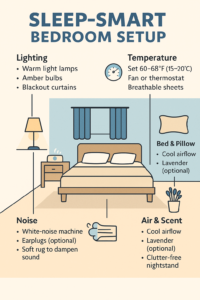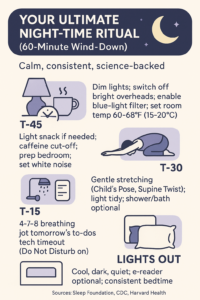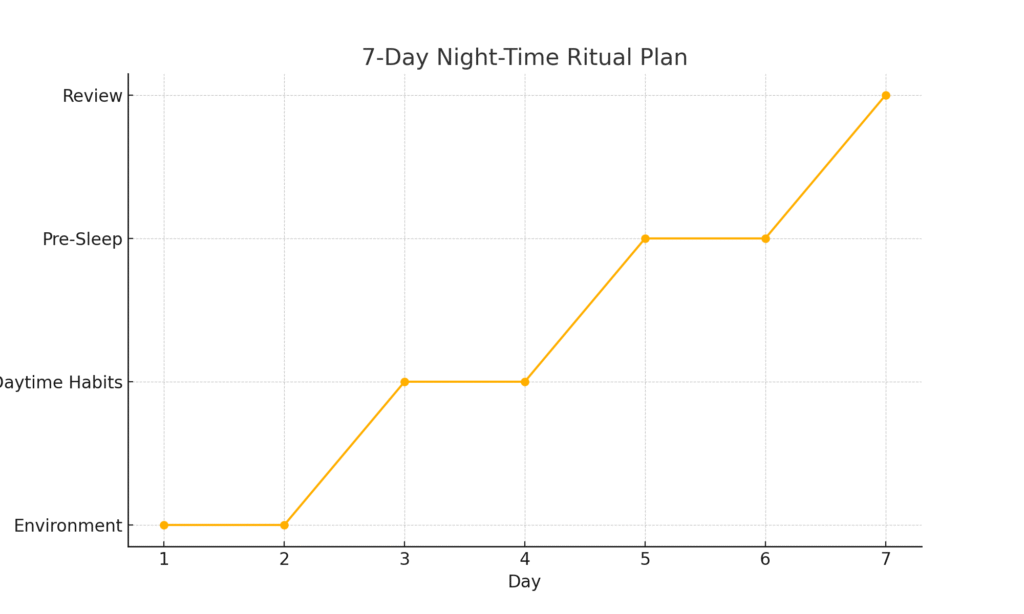Introduction – Embracing Your Personalized Night-Time Ritual
Tucking in at the end of a busy day shouldn’t feel like a race to the finish line. A thoughtful wind-down—your very own night-time ritual—can transform a chaotic evening into a soothing prelude to restful sleep.
Think of this guide as your companion, gently walking you through each element of an evening routine that’s grounded in science, wrapped in empathy, and sprinkled with a dash of lightheartedness.
In the sections ahead, we’ll:
- Build a sleep-smart environment that naturally nudges your body toward rest.
- Layer daytime habits that set the stage for deep slumber.
- Unpack a step-by-step pre-sleep routine to calm mind and body.
- Bust common myths that might be sabotaging your efforts.
- Introduce tracking tips so you can tweak and triumph night after night.
Whether you’re a chronic overthinker, a screen-glued night owl, or simply someone chasing a few more minutes of shut-eye, this ritual adapts to you. Let’s begin.
Step 1 – Crafting a Sleep-Smart Environment
The moment you walk into your bedroom, your senses should whisper, “Relax.” Your environment has a profound effect on how easily you drift off and stay asleep.
Lighting & Screens – Dimming the Digital Buzz
Harsh overhead lights and glowing screens send a false “daytime” signal to your brain, delaying the release of melatonin, the hormone that prepares you for sleep. Aim to reduce bright light at least 60 minutes before bed:
- Swap overhead bulbs for dimmable lamps or salt lamps.
- Use blue-light filters on devices (like F.Lux), or better yet, switch to a dedicated e-reader with an amber display.
- Consider blackout curtains to block streetlights or early-morning sun.
The science: A study published in Proceedings of the National Academy of Sciences found that blue-light exposure in the evening can suppress melatonin by up to 50% compared to dim light.
1 For more on screen habits and sleep latency, see this PubMed review.
Temperature & Noise – Finding Your Comfort Cocoon
Your core body temperature drops to initiate sleep. Keeping your bedroom between 60–68°F (15–20°C) helps this natural process:2
- Use a programmable thermostat or a retro-style fan.
- Lock in silence with earplugs, a white-noise machine, or a smartphone app (placed across the room so you’re less tempted to scroll).
- If you live in a noisy area, try a sound-conditioned blanket or calming playlist.
For official guidance on bedroom environment, check the CDC’s recommendations on sleep hygiene.
Bed & Bedding – Your Personal Comfort Sweet Spot
Your mattress, pillows, and sheets are the foundation of restorative sleep:
- Mattress firmness: Aim for medium-firm to support natural spinal alignment.
- Pillows: Choose based on your sleeping position—side sleepers need thicker support; stomach sleepers need a flatter cushion.
- Sheets: Opt for breathable fabrics like cotton or bamboo to wick moisture and regulate temperature.
- Weighted blanket: Subjective for many for sure, but I personally cant live without mine – for me, the weighted blanket allows me to be lost in comfort by applying gentle but firm pressure, as if you’re in a shroud. “The Science” behind this is known as “deep pressure stimulation”, activating the parasympathetic nervous system, sending you off to sleep.
If you’re shopping for a new mattress or curious about the best brands, keep an eye out for our in-depth mattress reviews coming soon.
Step 2 – Building Daytime Habits for Nighttime Success
Your daytime choices often set the stage for how you sleep. Small tweaks during daylight hours can lead to big improvements when your head hits the pillow.
Morning Sunlight – Setting Your Internal Clock
Natural light first thing in the morning signals your brain to stop producing melatonin and kick-start cortisol, helping you feel alert. Aim for 10–15 minutes of direct sunlight within an hour of waking:
- Sip your morning coffee on the balcony.
- Take a brisk walk around the block.
- Position your workstation near a window.
A study in the Journal of Biological Rhythms shows that morning light exposure significantly improves sleep quality and daytime alertness over weeks.
Caffeine & Meals – Fueling (and Not Fighting) Your Sleep
Caffeine can stay in your system up to 8 hours. To protect your sleep:
- Set a caffeine curfew at least 6–8 hours before bedtime.
- Choose green tea or decaf after midday.
- Eat balanced meals with protein, healthy fats, and fiber to stabilize blood sugar.
Heavy or spicy dinners can trigger indigestion. If you love a big evening meal, finish at least 2–3 hours before lights-out to give your body time to digest smoothly.
For more on nutrition’s role in sleep, see this Sleep Foundation guide to caffeine timing.
Movement & Stress Relief – Calming the Mind-Body Loop
Exercise boosts sleep quality—but timing matters:
- Aim for moderate cardio or strength training earlier in the day. Exercise produces cortisol and adrenaline…keeping your resting heart rate high…which is NOT conducive to a good nights sleep. Realistically, any heavy workout (eg HIIT, weight lifting) should be done (if possible) early in the morning.
- If you prefer evening workouts or simply are unable to work out any other time, keep them light (yoga, walking) to avoid a post-workout energy spike.
Stress management is equally vital:
- Practice a 5-minute midday breathing break. How you breathe during the day is how you will breathe at night. Breathing too hard (try and aim for less than 12 breaths per minute) can lead to snoring and sleep apnea…so regular “breathing breaks” during the day to ensure you are breathing nice and slowly are crucial (see below box breathing video)
- Use a quick guided meditation app to reset any time you feel tension creeping in.
Our deep dive on sleep and exercise offers routines that dovetail perfectly with this ritual.
Step 3 – Your Pre-Sleep Ritual
This is the heart of your night-time routine: a sequence of calming activities that cue your brain and body that it’s time to unwind.
Gentle Stretching & Yoga – Loosening Tension
Tension in your neck, shoulders, and back can send stress signals to your sympathetic (ie fight or flight) nervous system. Try these simple poses:
- Child’s Pose: Knees wide, arms forward. Breathe into any tightness.
- Supine Twist: Lie on your back, knees to one side. Hold for 30 seconds each side.
- Legs-Up-the-Wall: Feet against a wall, allowing hips to relax. Perfect for circulation.
Relaxation Techniques – Breathing, Meditation, Journaling
- 4-7-8 Breathing: Inhale 4 seconds, hold for 7, exhale 8. Repeat 4 times (see video above)
- Guided Imagery: Visualize a calm scene (beach, forest, quiet library).
- Journaling: Write down tomorrow’s tasks to clear your mind of to-dos.
These micro-practices help shift from fight-or-flight to rest-and-digest mode.
Technology Timeout – Apps Off, Headspace On
Screens trick your brain into staying alert. Establish a hard cutoff:
- Switch your phone to Do Not Disturb an hour before bed.
- Replace social media scroll with a short audio story or classical music playlist.
- If you need a sleep-assist app, choose one with an auto-shutoff timer.
Step 4 – Myth-Busting Common Sleep Hygiene Misconceptions
Even well-meaning advice can miss important nuances. Let’s clarify two big myths:
“Blue Light Is the Villain”
Yes, blue light delays melatonin. But you don’t have to banish all screens:
- Customer-grade blue-light glasses or screen filters can reduce up to 35% of blue light.4
- Dim ambient lighting and warm-hued bulbs go a long way.
- However, its not just “blue light” thats an issue here. What happens typically when you are doomscrolling social media late at night? Well, often you’re consuming media which is going to arouse emotions, be it anger, sadness, joy, curiosity…which is the opposite of what you want before bedtime. You want to stay clear of ANYTHING which may elevate your heart rate or cortisol levels – we all know what kind of controversial content is on social media, 9/10 its not conducive to a good nights sleep. It can wait until the morning.
Want to dive deeper? Harvard Health’s article on blue light’s impact is a must-read.
“Heavy Dinners Ruin Sleep”
It’s less about portion size and more about timing and composition:
- A balanced meal with lean protein, veggies, and whole grains is gentle on digestion.
- Leave a buffer—ideally 2–3 hours—between your last bite and bedtime.
- Digestion is heavy on your system – you ideally want to give your body as few reasons as possible to do any work other than recovering from the day’s exertions.
Step 5 – Track, Tweak & Triumph
Once you’ve tried the ritual, tracking what works (and what doesn’t) empowers you to refine it.
Sleep Journals vs. Apps – Finding Your Tracking Style
- Analog Journals: Simple, screen-free, and customizable with mood and dream notes.
- Apps: Automated metrics—sleep stages, heart rate—but can be pricey, sometimes inaccurate or distracting (see Oura Ring, FitBit, Whoop etc)
When to Seek Professional Help – Red Flags to Watch
If you’ve tweaked your environment and routine for several weeks with no improvement, or if you experience:
- Consistent trouble falling or staying asleep.
- Severe daytime fatigue affecting your daily life (despite having slept on paper an adequate number of hours..)
- Loud, chronic snoring or gasping at night.
Consider consulting a sleep specialist or your healthcare provider.
Conclusion & Next Steps
Congratulations on building the foundation for your Ultimate Night-Time Ritual. Here’s how to start:
- Day 1–2: Focus on environment—adjust lighting, noise, and temperature.
- Day 3–4: Layer in daytime habits—sunlight exposure and meal timing. Get that early morning exposure and establish that hard cut off every night, no ifs, no buts.
- Day 5–6: Add your pre-sleep ritual—stretching, breathing, and tech timeout.
- Day 7: Review your tracking data. Celebrate wins and plan tweaks.
For more sleep support, explore our pillars on Sleep Fundamentals and upcoming guides on Sleep Hygiene Tools.


